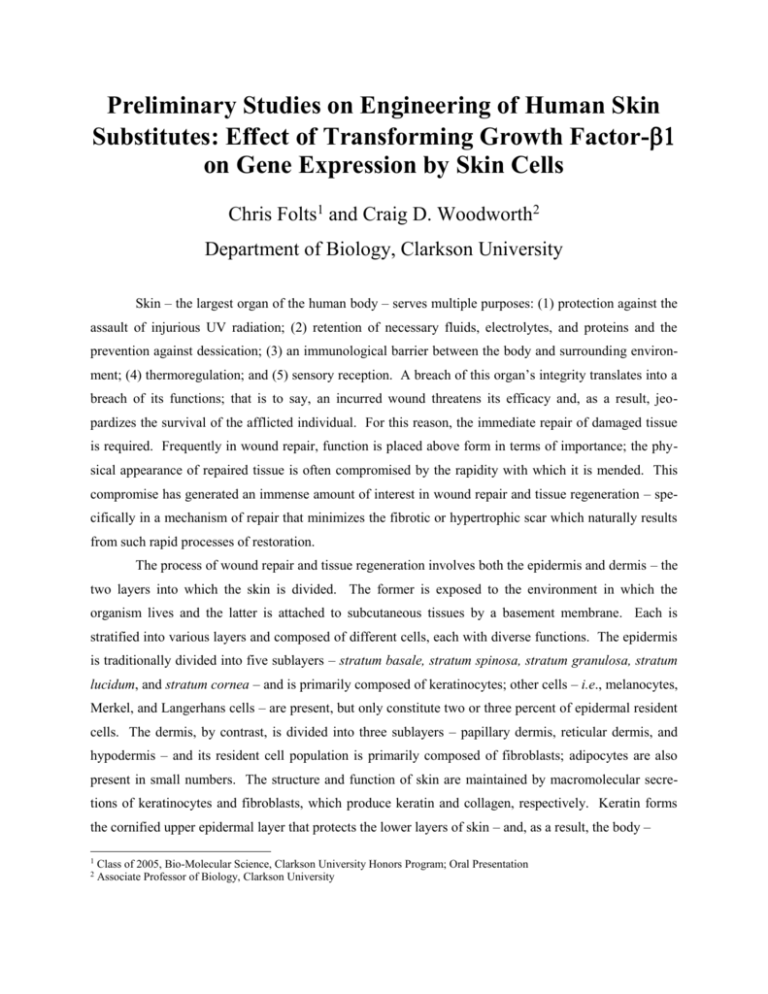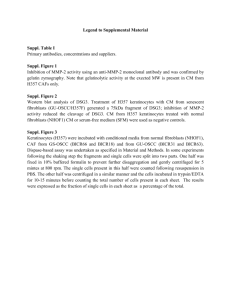The Effects of Type Beta1 Transforming Growth Factor on Fibroblast
advertisement

Preliminary Studies on Engineering of Human Skin Substitutes: Effect of Transforming Growth Factor- on Gene Expression by Skin Cells Chris Folts1 and Craig D. Woodworth2 Department of Biology, Clarkson University Skin – the largest organ of the human body – serves multiple purposes: (1) protection against the assault of injurious UV radiation; (2) retention of necessary fluids, electrolytes, and proteins and the prevention against dessication; (3) an immunological barrier between the body and surrounding environment; (4) thermoregulation; and (5) sensory reception. A breach of this organ’s integrity translates into a breach of its functions; that is to say, an incurred wound threatens its efficacy and, as a result, jeopardizes the survival of the afflicted individual. For this reason, the immediate repair of damaged tissue is required. Frequently in wound repair, function is placed above form in terms of importance; the physical appearance of repaired tissue is often compromised by the rapidity with which it is mended. This compromise has generated an immense amount of interest in wound repair and tissue regeneration – specifically in a mechanism of repair that minimizes the fibrotic or hypertrophic scar which naturally results from such rapid processes of restoration. The process of wound repair and tissue regeneration involves both the epidermis and dermis – the two layers into which the skin is divided. The former is exposed to the environment in which the organism lives and the latter is attached to subcutaneous tissues by a basement membrane. Each is stratified into various layers and composed of different cells, each with diverse functions. The epidermis is traditionally divided into five sublayers – stratum basale, stratum spinosa, stratum granulosa, stratum lucidum, and stratum cornea – and is primarily composed of keratinocytes; other cells – i.e., melanocytes, Merkel, and Langerhans cells – are present, but only constitute two or three percent of epidermal resident cells. The dermis, by contrast, is divided into three sublayers – papillary dermis, reticular dermis, and hypodermis – and its resident cell population is primarily composed of fibroblasts; adipocytes are also present in small numbers. The structure and function of skin are maintained by macromolecular secretions of keratinocytes and fibroblasts, which produce keratin and collagen, respectively. Keratin forms the cornified upper epidermal layer that protects the lower layers of skin – and, as a result, the body – 1 2 Class of 2005, Bio-Molecular Science, Clarkson University Honors Program; Oral Presentation Associate Professor of Biology, Clarkson University from desiccation and the absorption of deleterious UV radiation. Collagen – acting in conjunction with other ultrastructural molecules, e.g., laminin, fibronectin, and glycosaminoglycans – forms the extracellular matrix to which cells adhere and on which the morphology of the tissue as a whole is dependent. The layers of this tissue are studded with three ectodermal appendages: hair follicles, sweat glands, and sebaceous glands. Hair follicles or pilosebaceous units are not found in the soles of the feet or in the palms of the hand; their functions include insulation and moderate protection from UVB irradiation. Sweat glands are responsible for secreting a hypotonic saline solution that controls systemic thermoregulation by evaporative cooling. Sebaceous glands are found at the follicular bulge region of the hair and secrete sebum, an oil that covers the cornified epidermis and contributes to its antidesiccatory properties. While epithelial cells of the sebaceous gland (sebocytes) and follicular cells are of keratinocytic lineage, the origins of sweat glands are less clear. Normal wound repair is a carefully orchestrated process that involves most dermal and epidermal sublayers, and frequently these ectodermal appendages. It is traditionally divided into three overlapping phases: (1) inflammation; (2) proliferation; and (3) regeneration. In the first phase, neutrophils and eventually macrophages invade the wound bed; these consume any invading bacteria and other exogenous material. The release of specific cytokines – namely, PDGF, TGF-β, and TNF-α – by macrophages has been shown to facilitate the transistion from the first phase to the second. The second phase is characterized by the rapid proliferation of fibroblasts and the deposition of structural proteins, e.g., collagen, fibronectin, and α-actin, which compose the granulation tissue. This is responsible for the contraction of the wound and the formation of a fibrotic sheath for temporary protection. Simultaneously, a new extracellular matrix is produced, a highway by which keratinocytes on the wound’s marginal regions are able to migrate and ultimately differentiate into necessary cell lineages. The final phase may occur over a period of months or years; in it, the wound site returns to a prototypic, functional tissue by the processes of neovascularization, degranulation, and by the reduction of cellular number – specifically, those cells produced in phase two. This phase may – and frequently does – result in fibrotic scar tissue. A fibrotic scar is not always produced; it has been shown that scarless healing is common in embryonic and fetal wound repair pathways. Vascularization, ectodermal appendages, and prototypic function in general are restored after a wound is inflicted on an embryo or fetus. If the mechanisms by which fetal tissue is restored in a scarless manner can be elucidated, the medical or therapeutic repurcussions would be immeasurable. Several differences have been cited between fetal and adult tissues, ranging from different dermal fibroblasts to the expression of various cytokines (e.g., TGF-β). The process of tissue repair becomes complicated when a wound is thermally induced, i.e., a burn, especially if the affected area is large. One complication with skin replacements in burn and lesion patients is the absence of the three epidermal appendages. Epidermal and dermal layers, i.e., keratino- cytes and fibroblasts, can be replaced, but the re-installation of these appendages has been rarely accomplished in vivo. Methods of replacement are varied. For small and superficial burns (first-degree or epidermal burns), autologous keratinocytic samples can be excised from a donor site, cultured, and placed in the denuded wound. This is not effective or practical for larger or deeper burns (second- or thirddegree) for several reasons. First and foremost, a larger burn requires a larger grafted sample from the donor site; this increases the risk of infection and exposes the patient to excessive pain and discomfort. Second, deeper burns that involve the denudement of both epidermal and dermal layers cannot be as easily repaired or replaced as easily as superficial burns, i.e., a combined dermis-epidermis cannot be cultured as easily; in most cases, the dermis does not attach to subcutaneous membranes and as a result the engrafted tissue ceases to be a viable replacement. For these reasons, artificial tissues have been developed. They are varied – using autogenic or allogenic cell samples, or occasionally both – cultured on various substrates. In essence, these engineered tissues consist of a polymeric scaffolding that attempts to mimic the complex extracellular matrix of the dermis, which is seeded with fibroblasts, keratinocytes, and factors that aid in the processes of re-epithelialization, revascularization, and fibrosis. The science of drug delivery by degradable polymeric systems has been modified to form the necessary base analogs or substrates for these new tissue models. Some polymers being assayed include poly(lactide-co-glycolide), tyrosine-derived polycarbonates, and poly(ethylene glycol). The lab of Dr. Anja Meuller intends to test novel polymer scaffoldings and the lab of Dr. Craig Woodworth will provide biological/genetic data. The union of the two will hopefully be an improved skin substitute that avoids the complications of current models. The long-term aims of this project include (i) to provide a viable, polymeric delivery scaffolding seeded with chemokines or cytokines needed for modulated keratinocyte differentiation into the desired ectodermal appendages (e.g., hair follicles); and (ii) to provide a replacement or subsitute tissue that reduces hypertrophic scarring and the associated morbidity. The aim of the current study is to assay the activity of a cytokine involved in the process of fibrosis – TGF–β1. If fibrosis can be controlled by down regulating the production of structural proteins (e.g., collagen I and III) by fibroblasts, the morbidity associated with hypotrophic scarring may also be reduced. The effects of TGF–β1 on both fibroblasts and keratinocytes will be semi quanititatively assayed with reverse transcriptase polymerase chain reaction (RT-PCR). Two keratinocyte and two fibroblast sample populations were cultured according to standard protocol – keratinocytes in Keratinocyte Serum Free Medium (KSFM) and fibroblasts in Dubrecco’s Minimum Eagle Medium (DMEM/F12) – and grown to confluent monolayers at 37°C. Each experimental dish received 6 mL of respective media treated with 3 μL of a 3 ng/mL recombinant TGF–β1; each control dish received 6 mL of untreated, respective media. After 24 hours of exposure, RNA was extracted from all treated and untreated sample dishes from each of the four sample populations; the RNA was later purified and reverse transcribed into cDNA. The expression of various genes – including those believed to be affected by TGF–β1 (e.g., collagen Iα) and those associated with housekeeping (e.g., β-actin) for comparison – was assayed. This presentation will convey the data which were generated by these analyses of gene expression.






